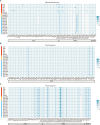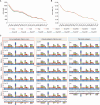Genomic variation and evolutionary patterns in organelle genomes between annual and perennial Glycine species
- PMID: 40102717
- PMCID: PMC11917018
- DOI: 10.1186/s12870-025-06312-4
Genomic variation and evolutionary patterns in organelle genomes between annual and perennial Glycine species
Abstract
Background: The complexity of structural variations and long stretches of repetitive DNA make the analysis of plant mitochondrial genomes (mitogenomes) exceptionally challenging. A thorough investigation of plant mitogenomes is essential for uncovering the evolutionary processes of plant organelles and optimizing traits related to plant cellular metabolism. The genus Glycine includes groups with both perennial and annual life strategies, making it an ideal subject for studying the complexity and variations of plant mitogenomes during evolution across different life strategies.
Results: Here, we assembled 20 complete mitochondrial and plastid genomes of Glycine accessions, including both annual and perennial species using the latest organelle genome assembly tool. Significant structural variations and differences in tRNA content were observed in the mitogenomes between the two life-history strategy subgenera, while protein-coding genes and rRNAs content were highly conserved. Distinct patterns of nuclear plastid DNAs and nuclear mitochondrial DNAs (NUPTs/NUMTs) were uncovered among annual and perennial species. Genes residing in NUMTs (NUMGs) showed a substantial presence in Glycine accessions, with annual soybeans exhibiting a higher proportion of protein-coding genes fully integrated into the nuclear genome. Phylogenetic analysis indicated a closely related evolutionary trajectory between mitochondrial and nuclear genomes in Glycine, providing supplementary evidence relevant to the evolutionary history of Glycine.
Conclusions: This study showed the structural variations and evolutionary patterns of mitochondrial genomes between annual and perennial Glycine species. These findings contribute to our understanding of plant organelle complexity, variation and history of intracellular genomic integration.
Keywords: Glycine; Intracellular transfer; Mitochondrion; Plastid.
© 2025. The Author(s).
Conflict of interest statement
Declarations. Ethics approval and consent to participate: Not applicable. Consent for publication: Not applicable. Competing interests: The authors declare no competing interests.
Figures






Similar articles
-
Insights into the nuclear-organelle DNA integration in Cicuta virosa (Apiaceae) provided by complete plastid and mitochondrial genomes.BMC Genomics. 2025 Feb 3;26(1):102. doi: 10.1186/s12864-025-11230-8. BMC Genomics. 2025. PMID: 39901091 Free PMC article.
-
Evolutionary trajectory of organelle-derived nuclear DNAs in the Triticum/Aegilops complex species.Plant Physiol. 2024 Jan 31;194(2):918-935. doi: 10.1093/plphys/kiad552. Plant Physiol. 2024. PMID: 37847157 Free PMC article.
-
Analysis of nuclear mitochondrial DNAs and factors affecting patterns of integration in plant species.Genes Genet Syst. 2017 Sep 12;92(1):27-33. doi: 10.1266/ggs.16-00039. Epub 2017 Feb 22. Genes Genet Syst. 2017. PMID: 28228607
-
Evolutionary dynamics of mitochondrial genomes and intracellular transfers among diploid and allopolyploid cotton species.BMC Biol. 2025 Jan 10;23(1):9. doi: 10.1186/s12915-025-02115-z. BMC Biol. 2025. PMID: 39794789 Free PMC article.
-
Cytoplasmic inheritance: The transmission of plastid and mitochondrial genomes across cells and generations.Plant Physiol. 2025 Apr 30;198(1):kiaf168. doi: 10.1093/plphys/kiaf168. Plant Physiol. 2025. PMID: 40304456 Free PMC article. Review.
Cited by
-
Assembly and comparative analysis of the complete mitochondrial genome of Cardiocrinum giganteum: a primitive Liliaceae group with significant scientific research value.BMC Genomics. 2025 Jul 1;26(1):602. doi: 10.1186/s12864-025-11817-1. BMC Genomics. 2025. PMID: 40597596 Free PMC article.
References
-
- Backert S, Nielsen BL, Börner T. The mystery of the rings: structure and replication of mitochondrial genomes from higher plants. Trends Plant Sci. 1997;2(12):477–83.
MeSH terms
Grants and funding
LinkOut - more resources
Full Text Sources

